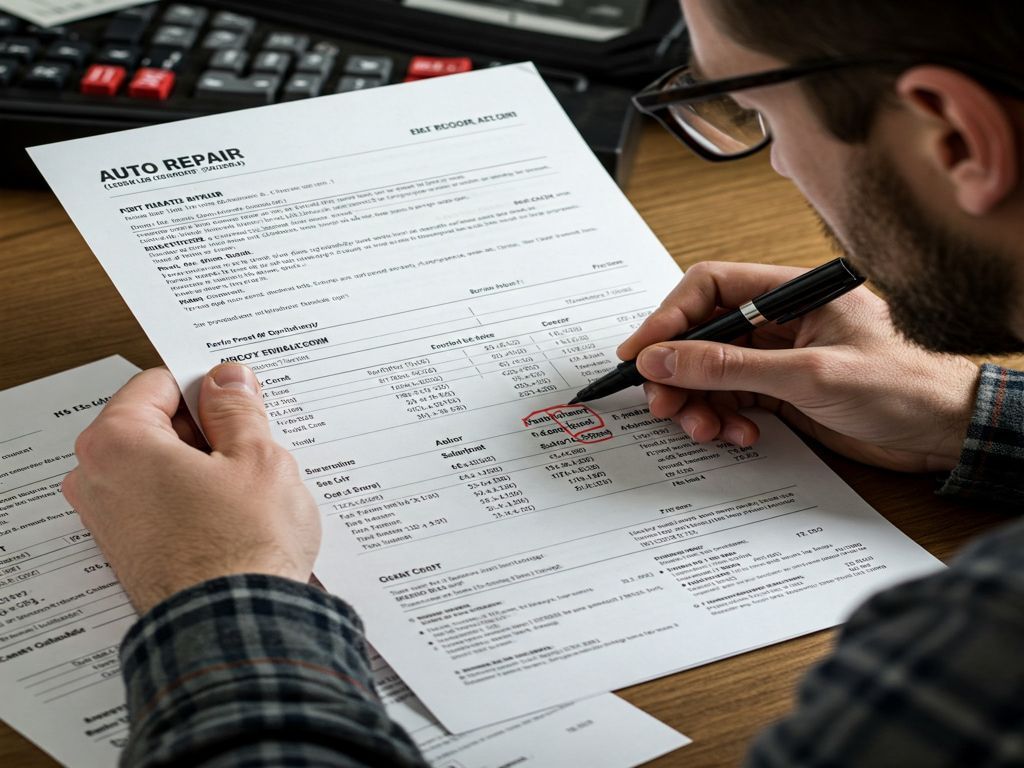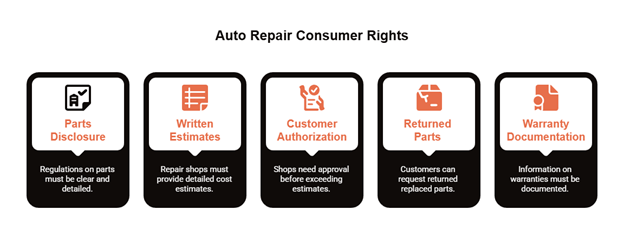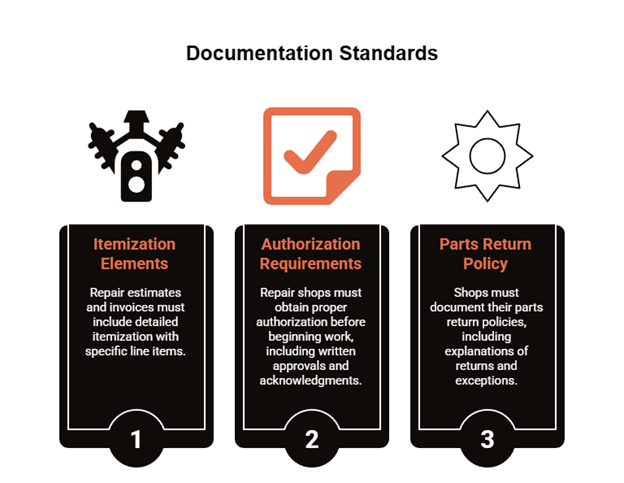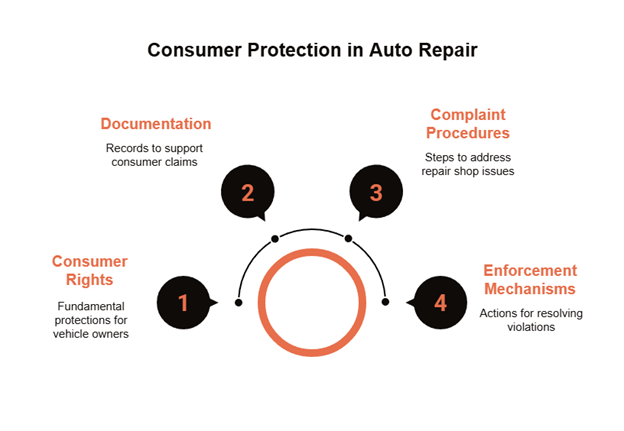
Tustin Consumer Protection Laws for Auto Repair Parts: What Local Shops Must Disclose
Key Takeaways:
- State Legal Framework: California's Automotive Repair Act establishes comprehensive consumer protections enforced by the Bureau of Automotive Repair (BAR), requiring shops to specify part types and provide written estimates.
- Parts Disclosure Requirements: Repair shops must clearly indicate whether parts are new, used, or rebuilt/remanufactured on both estimates and invoices, and must obtain customer authorization before making any changes.
- Documentation Standards: Proper documentation includes detailed itemization of parts with individual pricing, separate labor costs, clear identification of shop supply charges, and proper labeling of any environmental fees.
- Consumer Recourse Options: If you believe a shop hasn't followed disclosure requirements, first attempt resolution directly with management, document all communications, then file a complaint with the California Bureau of Automotive Repair.
Understanding these legal protections helps Tustin residents maintain their vehicles while avoiding unnecessary expenses and transforms them from passive consumers into informed advocates for their family's transportation needs.
The dashboard light flickers on. Again. When your vehicle needs repairs, understanding your consumer rights becomes vital - especially in Tustin where auto repairs represent both a practical necessity and a potentially significant household expense.
That moment of dread when your car starts making an unfamiliar noise? It's universal. But knowing what information repair shops must legally provide about parts can transform you from anxious car owner to informed consumer.
California's comprehensive auto repair consumer protection laws establish important safeguards around parts disclosure. These state-level regulations create a framework that ensures transparency throughout the repair process.
By understanding these protections, you can navigate repairs with greater confidence while avoiding unnecessary expenses.
This guide explores what auto repair shops must legally tell you about the parts they use in your vehicle under California law. You'll learn about the documentation required, what parts quality information must be disclosed, and what options exist if you believe a shop hasn't followed the rules.
California's Auto Repair Consumer Protection Framework

California offers robust protections for auto repair consumers through the Automotive Repair Act. This state-level framework establishes fundamental rights that benefit all vehicle owners, including Tustin residents.
The Bureau of Automotive Repair (BAR) oversees this regulatory system, enforcing standards for repair shops throughout California. They're the watchdogs. The ones handling consumer complaints, conducting shop inspections, and ensuring compliance with state regulations.
For Tustin vehicle owners, the BAR serves as the primary resource for addressing concerns about parts disclosure and other repair issues.
When it comes to parts disclosure, California law doesn't mess around. State regulations mandate that repair shops must:
- Specify whether parts are new, used, rebuilt, or remanufactured
- Provide written estimates detailing parts and labor costs
- Obtain customer authorization before exceeding estimate amounts
- Return replaced parts to customers upon request (with certain exceptions)
- Document warranty information for parts and repairs
These state-level protections form the foundation for consumer rights in Tustin and throughout California. While some areas might have additional business licensing requirements, the core parts disclosure regulations come from this state framework.
💡 Quick Takeaways
- Consumer protection foundation: California's Automotive Repair Act establishes comprehensive regulations enforced by the Bureau of Automotive Repair.
- Parts disclosure requirements: State law requires shops to identify part condition (new/used/rebuilt) and provide written estimates.
- Enforcement authority: The Bureau of Automotive Repair (BAR) serves as the primary enforcement agency for these regulations.
Understanding Parts Information Disclosure Requirements
When getting your vehicle repaired in Tustin, repair shops must provide specific information about the parts they plan to use. This isn't optional—it's the law.
Understanding these disclosure requirements helps you evaluate repair recommendations and make informed decisions about your vehicle's maintenance.
The difference between different types of parts isn't just technical jargon – it directly impacts your wallet and your vehicle's performance.
New vs. Used vs. Remanufactured Parts Disclosure
California law requires repair shops to clearly indicate on both estimates and invoices whether parts fall into these categories:
- New parts: Never used before, meeting original manufacturer specifications
- Used parts: Previously installed in another vehicle but still functional
- Rebuilt or remanufactured parts: Previously used components that have been restored to working condition
This disclosure must appear in writing on both the estimate and final invoice. Verbal explanations alone don't satisfy the legal requirement. Not even close.
When parts categories change between the estimate and actual repair, shops must obtain your written authorization before proceeding. No exceptions.
You might wonder why this matters so much. Picture this: you're quoted for a new water pump, but the shop installs a rebuilt one without telling you. Even if it functions properly, you've paid new-part prices for something that isn't new. That's exactly what these disclosure laws prevent.
Quality and Price Options Documentation
Beyond basic part types, California regulations encourage repair shops to discuss quality and price options. While not mandated to offer multiple options, shops that do provide choices should document:
- Different quality levels available (such as economy, mid-grade, premium)
- Price differences between options
- Potential differences in warranty coverage
- How different quality levels might affect performance or durability
This information helps you understand the options available and make informed decisions based on your vehicle's needs and your budget constraints.
Having these options clearly documented prevents miscommunication and ensures you know exactly what's being installed in your vehicle.
Warranty Information Requirements
Warranty documentation for parts represents another crucial disclosure area. California law requires shops to provide:
- Written warranty terms for each part installed
- Duration of coverage for different part types
- What aspects of the part are covered (materials, workmanship, or both)
- Process for addressing warranty claims if issues arise
[ILLUSTRATIVE EXAMPLE]
Consider a situation where someone needs a major engine component replacement. The repair shop's estimate should clearly state whether they're installing a new part directly from the manufacturer, a remanufactured part rebuilt to meet quality standards, or a used part from another vehicle.
The documentation would specify not just the part type, but also its warranty coverage period (which typically varies significantly between these options). For instance, a new water pump might carry a 12-month/12,000-mile warranty, while a remanufactured one might offer 90 days/4,000 miles, and a used part could have minimal or no warranty.
[END EXAMPLE]
These warranty disclosures help you understand the long-term value proposition of different repair options, particularly important for maintaining family vehicles over extended periods.
💡 Quick Takeaways
- Part condition clarity: Shops must specify whether parts are new, used, or rebuilt/remanufactured.
- Options documentation: Repair facilities should document different quality levels and pricing when offering choices.
- Warranty documentation: Written warranty terms must be provided for all parts, including coverage duration and claim processes.
Estimate and Invoice Documentation Standards

Proper documentation serves as your protection throughout the repair process. Your shield against surprises. California's requirements establish specific standards for estimates and invoices that shops must follow.
Ever received a repair bill with mysterious charges lumped together? Frustrating, isn't it? That's precisely what these documentation standards prevent.
Required Itemization Elements
Repair estimates and invoices must include detailed itemization with:
- Separate line items for each part with individual pricing
- Labor costs broken down by specific repair procedures
- Shop supply charges clearly identified and explained
- Environmental fees or other regulatory costs properly labeled
- Tax calculations shown separately from parts prices
This detailed breakdown prevents shops from hiding costs in general categories and helps you understand exactly what you're paying for. The itemization should be specific enough that you could theoretically source the parts independently if desired.
Authorization Documentation Requirements
Before beginning work, repair shops must obtain proper authorization through:
- Written approval for the initial repair estimate
- Additional authorization for any supplemental work discovered
- Signed acknowledgment when part types change (such as substituting rebuilt for new)
- Documentation of any price changes from the original quote
- Authorization records maintained for at least three years
These authorization requirements prevent shops from performing unauthorized work or substituting different parts without your knowledge. Original copies must be provided to you, while the shop maintains its own records as required by state regulations.
You might think this documentation seems excessive. Until that moment when a dispute arises. Then these papers become your strongest ally in resolving the situation fairly.
Parts Return Policy Documentation
Shops must also document their parts return policies, including:
- Written explanation of which parts you're entitled to receive back
- Documentation of any parts that must be returned to manufacturers for core charges or warranty processing
- Clear explanation of hazardous materials exceptions where parts cannot be returned due to environmental regulations
- Records of parts disposition if you decline to take removed components
Understanding these documentation standards helps you protect yourself throughout the repair process. By knowing what paperwork to expect and review, you can ensure compliance with state requirements while making informed decisions about your vehicle's maintenance.
💡 Quick Takeaways
- Detailed breakdowns: Estimates and invoices must separately itemize each part, labor procedure, and additional charge.
- Written approvals: Shops must document your authorization for initial work and any changes discovered during repairs.
- Parts return clarity: Clear documentation must explain which parts you can receive back and any exceptions.
Consumer Rights and Recourse Options

Understanding your rights and knowing what to do if they're violated provides important protection for Tustin vehicle owners. California's consumer protection framework includes specific mechanisms for addressing issues with auto repair parts disclosure.
Most repair facilities follow the rules diligently. But what about those that don't? That's where these recourse options become crucial.
Documentation to Maintain for Protection
To protect yourself effectively, maintain these records:
- Original copies of all estimates and authorizations
- Final invoices with detailed parts information
- Written warranty documentation for each part
- Records of any communication about parts quality or substitutions
- Photographs of parts if concerns arise about quality or condition
Store these documents in a safe place for at least the duration of any parts warranty, and preferably as long as you own the vehicle. Digital backups provide additional security against loss or damage to paper records.
That folder of repair receipts you've been stuffing in your glove compartment? It might be time to organize it. These documents aren't just clutter – they're potential protection.
Complaint Filing Procedures
If you believe a repair shop hasn't followed disclosure requirements, follow these steps:
- First attempt resolution directly with the repair shop management
- Document all communications about the issue
- File a complaint with the California Bureau of Automotive Repair (BAR)
- Provide copies of all relevant documentation with your complaint
- Follow up with the BAR about the status of your complaint if needed
Your complaint should specifically reference which disclosure requirements weren't met and include copies of any documentation that demonstrates the compliance failure. The BAR website offers an online complaint system, or you can call their consumer hotline for assistance.
The hope is you'll never need these steps. But knowing them gives you confidence to address problems if they arise.
Enforcement Mechanisms Available to Consumers
When violations occur, Tustin residents can access several enforcement mechanisms:
- BAR investigations and administrative actions
- Mediation services through the BAR or consumer protection agencies
- Small claims court for disputes up to $10,000
- Documentation-based negotiation with the repair facility
- Civil litigation for larger disputes or pattern violations
These enforcement options provide multiple paths to resolution based on the severity of the violation and your specific circumstances. Most issues can be resolved through proper documentation and straightforward communication with the repair facility, particularly when you clearly understand the disclosure requirements.
💡 Quick Takeaways
- Record keeping: Maintain all repair documentation for at least the warranty period, preferably longer.
- Complaint process: First attempt direct resolution, then follow specific steps for filing with the Bureau of Automotive Repair.
- Multiple recourse options: Enforcement mechanisms include state agency investigation, mediation, and court options when needed.
Protecting Your Family's Vehicle Investment
Understanding California's auto repair parts disclosure requirements helps you maintain your family vehicle while avoiding unnecessary expenses. By knowing what documentation to expect and how to verify compliance, you gain valuable tools for making informed decisions about your vehicle's maintenance.
The transparency created by these state requirements directly addresses the primary concerns of Tustin families: maintaining reliable transportation while controlling costs.
When repair shops properly disclose part conditions, quality options, and warranty information, you can evaluate choices based on your specific needs rather than accepting recommendations without context.
Next time your family vehicle needs repairs, take a moment to review the documentation provided by the shop. Verify that it meets the disclosure standards outlined here, and don't hesitate to ask questions if information is missing or unclear.
By actively participating in the process and understanding your rights, you transform from a passive consumer into an informed advocate for your family's transportation needs.
Finding a reputable car repair store that follows these disclosure standards is crucial for long-term vehicle repair value.
Frequently Asked Questions (FAQs)
Q: How do I know if an auto repair shop is following proper parts disclosure laws?
A: Legal parts disclosure requires shops to clearly identify on your estimate and invoice whether parts are new, used, rebuilt, or remanufactured. They must also provide warranty information for each part and itemize parts costs separately from labor.
Additionally, shops must get your written authorization before substituting different types of parts than originally quoted. You can verify compliance by checking that your paperwork includes these specific details and that the shop obtained proper authorization for any changes.
Q: What documentation should I receive about auto repair parts, and how long should I keep it?
A: You should receive a detailed written estimate that itemizes each part with its condition (new/used/rebuilt), a written authorization form that you sign before work begins, and a final invoice that matches the authorized work with specific part details including warranty information.
California law requires shops to provide parts warranty documentation separate from labor warranties. Keep these documents for at least the duration of any part warranty period plus one year.
For major component repairs, consider maintaining records for the entire time you own the vehicle, as these documents provide crucial evidence if quality or compliance issues arise later.
Q: What's the difference between OEM and aftermarket parts, and what should my repair documentation tell me about this?
A: OEM (Original Equipment Manufacturer) parts are made by or for the vehicle manufacturer and are identical to the parts that came with your vehicle when new. Aftermarket parts are made by third-party manufacturers and may vary in quality and price.
Your repair documentation should clearly indicate which type is being used, as this can affect both performance and warranty coverage. California regulations require that shops disclose part types and obtain your authorization before making substitutions.
The documentation should also include warranty information for whatever parts are installed, as coverage typically differs between OEM and various aftermarket options.
Frequently Unasked Questions (FUQs)
Q: How do auto repair parts disclosure requirements apply to vehicles still under manufacturer warranty?
A: An important but often overlooked aspect of consumer protection involves vehicles still under manufacturer warranty. While using aftermarket parts generally won't void your entire vehicle warranty (contrary to common misconception), it could affect coverage for related components.
Under California regulations, repair shops should inform you if using certain parts might affect your vehicle's existing warranty coverage. Good repair facilities typically provide documentation about potential warranty implications and may recommend OEM parts for systems still under manufacturer warranty.
This disclosure helps you make informed decisions about maintaining warranty coverage while managing repair costs.
Q: How can I verify if rebuilt or remanufactured parts meet quality standards?
A: Many consumers don't realize they can request specific information about rebuilt or remanufactured parts. California regulations require that shops disclose when these part types are used, but quality can vary significantly between providers.
Request documentation about which company remanufactured the components and what standards they follow. Quality rebuilders typically offer warranties comparable to new parts and follow industry certification programs.
Your repair documentation should include the remanufacturer's name and warranty terms, allowing you to research their reputation. This information helps you evaluate whether the rebuilt parts meet appropriate quality standards for your vehicle repair needs.
Honest Repairs. Clear Documentation. Trusted by Tustin Drivers.
At Orange Independent Auto Repair, we take the guesswork out of car repairs. With a strong commitment to transparency, safety, and long-term value, our team ensures you know exactly what’s going into your vehicle — from part type to warranty coverage.
Whether you're driving a modern commuter, classic cruiser, or high-performance European vehicle, our certified technicians deliver top-tier service tailored to your needs.
Why Tustin drivers trust us:
- ✔️ Clear part and warranty disclosures
- ✔️ Experienced mechanics for all makes and models
- ✔️ Specialized care for Porsche, classic, and European vehicles
- ✔️ Fair pricing and real-time updates throughout your service
📞 Have questions or need trustworthy repairs? Contact us today and experience service the way it should be.
“This business is incredible. Family owned with a family feel. Fast service, great communication and fair prices. You won't wonder about the progress of your vehicle, you will be contacted every step of the way. I've been coming here for years and trust only Orange Independent with my vehicles. Thank you!” — Ian Anderson

